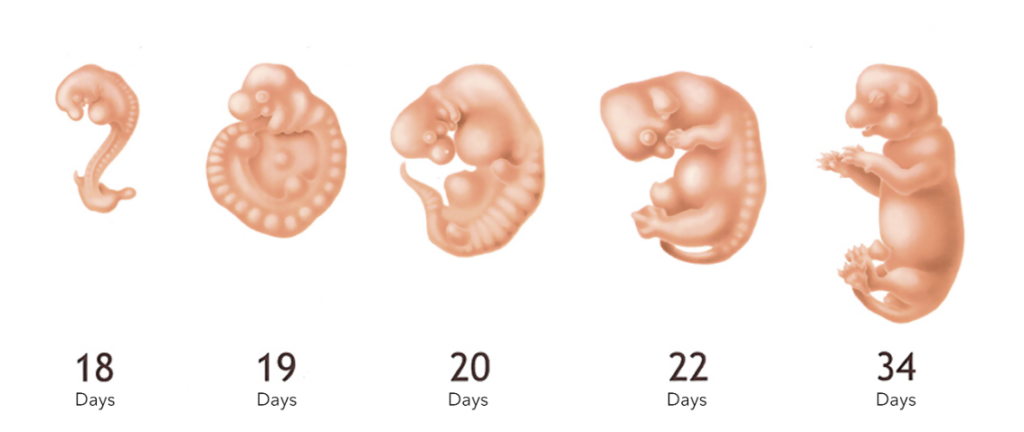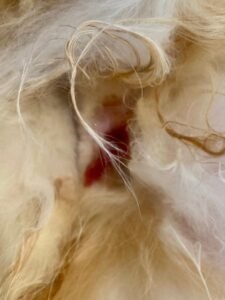Maine Coon Pregnancy: Maine Coons tend to have a longer gestation period than smaller breeds of cats. While most cats will be pregnant for 60 – 65 days with most of them delivering by day 63, Maine Coons tend to be pregnant 65 – 72 days with most delivering by day 67 and whereas most cats may be able to get pregnant by 4 months of age, Maine Coons are not likely to experience their first heat and be able to get pregnant until they are 6 to 12 months old.
When a breeder decides to breed their Maine Coon, they tend to wait until the cat is at least a year old to allow for more physical maturity and growth. This is because younger queens tend to have smaller litters and smaller kittens, because they are still growing themselves and still need the extra nutrients. Breeding female cats are called queens and the act of having kittens is called queening or kittening.
Breeding should be managed under controlled conditions with the queen in heat and calling for a male. She should be placed with the male (stud) and the first day and time they copulate successfully should be recorded for date planning. If there is a successful union between the queen and the stud, you will likely hear a very angry hissing and/or growling noise or even a scream, and at this time the two cats will fall away from each other and the queen will writhe and roll around on her back. The male, if he’s experienced and smart, will keep his distance during this time to avoid being slapped at or bitten by the queen.
If the mating is successful and pregnancy occurs there are signs that may be noticeable in as early as 3 weeks. The first sign which often occurs at or around 3 weeks is called “pinking up” of the nipples. This is seen as the nipples enlarging and getting darker pink. This is also when morning sickness may first occur. Just like humans, some queens can experience nausea and vomiting associated with the hormonal changes of pregnancy and although it is called morning sickness, It can occur at anytime of the day and at any point throughout the pregnancy.
Let’s look at what is happening week by week during pregnancy.

Weeks 1 – 2: Starting at breeding, also called conception, the act of copulation triggers the queen to ovulate or release eggs (Ova). It then takes from one to seven days for the male’s sperm to fertilize the eggs. Once fertilized, the eggs develop into embryos which will implant into the walls of the queen’s uterus at around seven to 14 days after conception.
Weeks 3 -4: Now is the time that the queens nipples will likely start to pink up and morning sickness may first appear. The embryos enter into a stage called embryogenesis, it is during this critical time that the embryo’s develop recognizable features such as heads, limbs and tails and the internal organs are also forming as well.
Weeks 5 – 8: The embryo’s complete embryogenesis and now become fetuses. They are recognizable as being fully formed and although they still do not have their fur, fun fact, they do have tiny claws. The queen begins to look pregnant with a rounded belly and by week 8 tiny kicks and movements can be felt by a hand laid gently on the queens abdomen. One should never try to palpate the queens abdomen to feel her kittens, this should only be done by a trained veterinarian and only if necessary.
Weeks 8 – 10: During this time period, hair and paw pads develop and the fetuses grow rapidly to their birth size and weight which for Maine Coons can range from 3 – 6 ounces although with larger litters they may be less than 3 ounces. As she approaches week 10, the queen’s belly will continue to get larger and rounder. She may eat smaller but more frequent meals and movement of the kittens becomes visible as the space in her abdomen decreases. As her time for queening approaches other noticeable changes may occur in the queen. She may become more maternal and affectionate, wanting to always be at her owner side. She may begin purring constantly and poking around looking for a place suitable to deliver her kittens, this is referred to as nesting behavior. Her breasts may engorge and become tender, and her nipples continue to enlarge and they may start to look crusty as small amounts of colostrum leaks from them, this often occurs 24 – 48 hours before labor begins. Usually, somewhere around day 65 the kittens have developed enough to trigger labor in the queen. Scientist now believe that when the kittens are mature enough to survive outside of the queen, they will release a small amount of a protein that will cause the queen’s body to start releasing hormones that initiate labor. When this happens the queen enters stage 1 of labor.
Maine Coon Pregnancy: Labor
Labor is divided into three stages.
Stage 1 – This is called early labor. Although it is unlikely that any visible changes can be seen in the queens behavior, there is a lot going on inside. Often the queens body temperature will decrease, dropping below 100F. Normal body temperature for cats ranges from 100.5 to 102.5F. Contractions have started and initially may be irregular and mild, but like human labor, they will gradually become more regular and more painful. The cervix is also in the process of dilating, which is indicated by the queen passing her mucus plug or having a “bloody show”. However, the queen often cleans it quickly away, so, this sign often gets missed by the breeder. She may also become restless. This stage can last up to 36 hours in new queens, but may be only as long as four hours in an experienced queen.

Stage 2 – Active labor begins. As the queens contractions become regular, stronger, and more painful. She may vocalize or call out during each contraction and as they become more painful, she will begin to pant, sometimes with her mouth open, sometimes not. This is a very good sign that birth is close at hand. As the contractions move a kitten into the birth canal, the queen will begin to strain or bear down to push the kitten through the pelvis and out into the world. As this occurs, it is not uncommon for the sack still filled with the protective fluid that surrounds the kitten to bulge out ahead of the kitten and/or for it to rupture spontaneously causing a gush of fluid prior to the kitten presenting. Then, usually, within just a few minutes of starting to strain, the kitten is born.
Stage 3 – After the arrival of the kitten the queen usually enters the third stage of labor which is delivery of the placenta or afterbirth. Although sometimes another kitten may be born before she passes both the first and second kitten’s placentas. The delivery of the placenta most often occurs within 5 to 15 minutes of delivering the kitten. It is during this stage that the queen usually takes the time to tear the sack away from the kittens face and head and to vigorously clean first their nose and mouth area and then it’s whole head, working her way down the kittens body. She may also separate the umbilical cord from the placenta by chewing and tearing it and once the placenta is delivered, go on to eat it. If there are more kittens, then the whole process starts all over again until all of the kittens have been born. Though even here, there is a Caveat, sometimes the queen will take a break and several hours may pass between kittens being born, and occasionally, even days may pass between kittens.